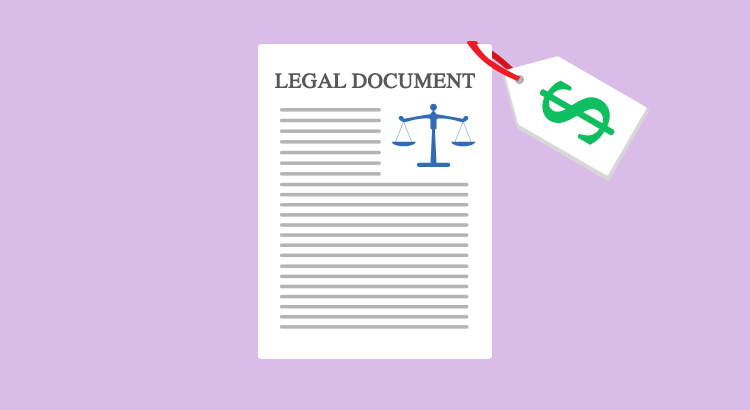Legal services are becoming increasingly automated and commoditized as technology infiltrates the industry. As a result of this shift, the legal business model is changing. We’ve blogged at length about why the hourly business model is broken and how the billable hour is dying. But due to the longstanding tradition of time-based billing and the change resistant nature of the legal industry, many law firms struggle to make the switch. In this post, we’ll lay out a simple framework that lawyers can use to determine how much to charge for flat fee legal services in order to help your firm keep up with the changing times.
Estimate the Value Your Client Receives
The cost of any product or service should be at least loosely tied to the value received by the customer. If the imbalance between cost and value is too high, people will refuse to pay, and you’ll go out of business.
The fact of the matter is that your clients do not want to pay for your time. The amount of time spent rendering the services is completely irrelevant for the client. But, they will be happy to pay for the value they receive from working with you.
Keep in mind that this does not mean that you have to charge less by any means. In fact, you might even be able to charge more with a flat fee than you would charge by the hour in certain instances.
However, the starting point for determining the price of flat fee legal services should not be the time required to perform the service. It should always be based on the value your client gets in return.
How to Measure Value
The hardest part about this approach to pricing is that measuring the value a client receives from legal services is much more of an art than a science.
There isn’t a magic formula where you can simply plug in some numbers and calculate it. You have to get creative and look closely at how clients benefit from their relationship with you. Then you do your best to assign a dollar amount to these benefits.
Here are the major ways that clients benefit or derive value from legal services:
Increased wealth or income
Sometimes clients benefit from legal services through a direct financial gain. This is most common with contingency based services rather than flat fee. But it can also be applicable in transactional law, such as M&A deals or intellectual property/licensing.
It is one of the most important factors to consider when it does apply, because it is usually the easiest thing to measure.
Reduced risks
The purpose of many legal services is to reduce the risks clients face. For example, estate planning helps clients protect their assets, and contracts help reduce the risk of facing lawsuits or liability in the future.
Reducing risks is one of the most common ways clients benefit from legal services, so it’s always important to consider when making your pricing decisions. You can help your clients understand the value of your services more clearly by illustrating how much the risks would potentially cost them if any of them came to fruition.
Decreased expenses or liabilities
Some legal services help reduce the expenses or liabilities facing a client. For instance, debt reduction, tax related services, or negotiating settlements in defense cases are all examples of how legal services can reduce the amount of money a client owes to another party.
This is also a more easily measurable form of value, like direct financial gains. So you should use it to your advantage when determining your pricing, if it applies.
Improved reputation
In certain circumstances, working with a law firm can be a source of prestige or reputation enhancement. This is particularly apparent for startup companies in the venture capital world. Working with a top tier law firm can help these companies make important business connections or simply enhance their credibility.
The prestige of your law firm is another factor that can enhance the value perceived by a client, although it is much more difficult to measure with a dollar amount.
By looking at these four factors, you can start to come up with a dollar figure to represent how much your services are actually worth to a client. This is the first, and most important step to determine an appropriate price to charge for flat fee legal services.
Determine Your Own Costs
Next, you will want to measure your own costs to provide the services to ensure that you are staying profitable. The basic formula to measure profitability is as follows:
Profits = Revenue – Expenses
In other words, your revenue has to be higher than your expenses, or you’ll be losing money. This is why the next thing to factor into your pricing determination is the total costs incurred by your law firm. It’s important to identify and understand attorney expenses when determining your costs as a firm.
Fortunately, legal services have pretty high margins. Unlike other industries, where parts or raw materials must be purchased upfront in order to produce the end product, or where expensive equipment is required to serve every client, the costs to provide legal services are fairly minimal.
The major costs to consider are things like rent, labor and wages, subscriptions to research databases, software costs, computers/printers/hardware, office supplies/paper/ink (unless of course you have gone paperless), marketing and other costs to acquire a client, and travel.
How to Calculate the Costs
It’s difficult to accurately measure the costs incurred for any particular client’s legal matter. But you can get a good idea by summing up your total monthly expenses, and dividing by the total number of clients serviced in an average month.
You should also break this down by the type of matter, since some matters inevitably require much more work than others. This is one reason why keeping accurate data is so important to running a business.
For example, if you spend $10,000 per month in expenses and you serve an average of 20 clients with one similar type of matter, your average expenses to acquire and service these clients are about $500 ($10,000 / 20 = $500).
This means you would need to have a price point above $500 in order to generate a profit on this particular matter type.
You may like these posts
Find a Win-Win Price in Between
Once you know how much your services are worth to your clients, and how much the services cost your firm to provide, the final step is to establish a win-win price point. Win-win means that both sides should “profit” from the relationship.
But how can a client profit when they are spending money on services? Well, just like your law firm profits by charging more money than it costs to deliver services, your clients can profit by paying less for the services than the value they receive from them.
Client’s Profits = Value of Services – Price of Services
Using this formula, we can see that the price of flat fee legal services should be an amount that is in between the value they receive from the services and the costs your firm incurs to deliver the services.
For example, if the client receives about $5,000 of value from the services, and it costs your firm $1,000 to acquire the client and deliver the services, your price point should be somewhere between those two numbers. That way, both parties are coming out ahead in the transaction.
The exact price you decide on can be as high as you would like, up to $5,000. If it’s any more than $5,000, you run the risk of losing those clients.
Ultimately, the amount you can charge for your services while still making the client feel like they are profiting will depend on your ability to convey the value of your services to the client. That’s where your sales process comes into play.
Summary
As the legal business model shifts away from hourly billing toward alternative fee structures, it’s important for lawyers to develop an understanding of basic pricing principles in order to remain profitable.
Knowing how much to charge for flat fee legal services is no easy task, but it all starts with understanding the true value that your clients receive, as well as the costs incurred by your firm.
Generally, the four major factors which determine the value of legal services for a client are below:
- Direct financial gains
- Reduced risks
- Decreased liabilities
- Enhanced reputation
By effectively communicating these forms of value to your clients, you can maximize your prices, while still creating a win-win scenario where your clients are able to profit from the relationship as well. And that is the key to both satisfied clients, and a healthy business.
We published this blog post in January 2018. Last updated: .
Categorized in: Business








